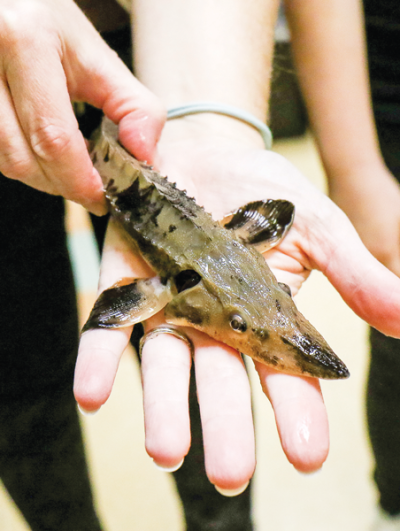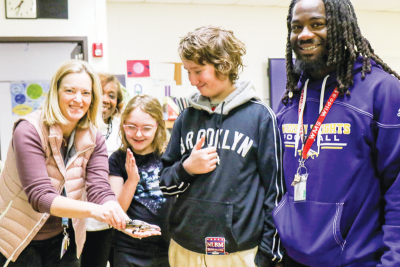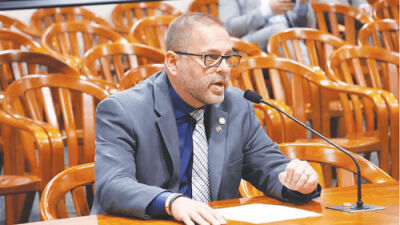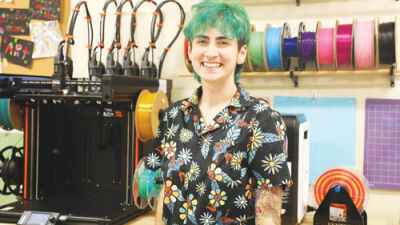
While the fish is small now, a fully grown lake sturgeon can exceed 6 feet in length and weigh more than 200 pounds, and some have been known to live up to 150 years. The fish, once common in the Great Lakes, is all but extinct due to overfishing and habitat degradation.
Photo by Patricia O’Blenes

Laura Shultz, a teacher at Wilkinson Middle School, shows off “Spike,” the lake sturgeon she and her students are raising for release into the wild. The effort is part of a program through the state that aims to restore the endangered species.
Photo by Patricia O’Blenes
MADISON HEIGHTS — The lake sturgeon is among the oldest and largest native species of fish in the Great Lakes — living up to 150 years, reaching lengths of more than 6 feet, and weighing more than 200 pounds when fully grown. They’re also nearly extinct, leading to efforts to raise them in captivity so they can once again thrive in Michigan’s waters.
A juvenile specimen is currently being raised in the classroom of Laura Shultz, a teacher at Wilkinson Middle School in the Madison District Public Schools.
“The sturgeon has been around since the time of the dinosaurs. It pretty much is a dinosaur,” Shultz said. “And my students can see it up close and personal.”
Shultz has partnered with a nonprofit called St. Clair Detroit River Sturgeon for Tomorrow, which aims to protect the species within the Huron-Erie Corridor.
The nonprofit, in turn, administers a program called “Sturgeon in the Classroom” through the Michigan Department of Natural Resources, which supplies the fish and a permit to handle them.
Shultz received hers earlier in the fall. She feeds it, cleans its tank, and measures its growth on a regular basis. Sometimes she is helped by her students. As part of the arrangement, she also keeps the DNR updated with coordinates of the fish’s location.
The fish is currently about 7 months old — still too young to know its gender. A schoolwide survey led to it being named “Spike,” although Shultz quietly prefers the name “Bubbles.”
“Sturgeon are weird-looking fish, so my students were like, ‘Ew, what is that thing?’ And I said, ‘Hey, don’t talk about my baby like that!’ They felt bad when I teased them,” Shultz said. “But it’s really cute how they’ve come around. Now they ask to see the fish and ask how it’s doing.”
In the spring, Spike will be ready for release into the wild on a field trip to Belle Isle. It will be tagged with a chip that will help identify it if it’s recaptured.
The waters of Michigan were once teeming with lake sturgeon, which contrary to its name also appear in rivers. Prior to the 1800s, they were so common that they were a nuisance to fishermen, causing damage to fishing nets. But then they became valued for their flesh, eggs and organs, leading to overharvesting that decimated stocks by the early 1900s.
Their numbers continue to dwindle due to habitat degradation caused by logging and other forms of industry. Dam construction hindered access to spawning sites, putting the sturgeon on the path to extinction. But in recent decades, rehabilitation has become a priority, and efforts have been made to rebuild the sturgeon population.
Shultz first learned of the concept through a similar effort aimed at the arctic grayling — another species native to Michigan that has disappeared from the Great Lakes.
When her son was in elementary school several years ago, he raised money for an effort to reintroduce arctic graylings to Michigan. Through this, Shultz formed connections that fast tracked the approval of her application for the sturgeon program.
Now, her class at Wilkinson is one of a dozen in Southeast Michigan to be raising a specimen. Shultz has made presentations about it for each of the science classes at Wilkinson. It also led to the formation of the Environmental Club, where students from all grades meet up during lunch to discuss the impact of human activity on the Earth and what they can do to help. The sturgeon has already served as a catalyst for talks about watershed health, ethical fishing and more.
Recently, Shultz challenged her club members to think of their own “passion projects” related to the environment. Maybe a student is concerned about pollution in the ocean, for example, or the survival of monarch butterflies. Shultz will then work with them on action plans such as fundraisers and public awareness campaigns.
“I want them to feel inspired, and to know that they can make a difference,” Shultz said.
Asenath Jones-Richmond, the principal at Wilkinson Middle School, said she is astonished by how Shultz’s sturgeon project has grown into something so much more.
“When she first got approved for the fish, she came to me and said this was something we could do, and I told her she had our full support. Everyone was on board,” Jones-Richmond said. “We’re just flabbergasted with the knowledge we’re gaining. And the children simply love it. It’s just been a very impactful thing for our students, caring for the fish and checking in on it. It builds up their socio-emotional learning. And living in Michigan surrounded by all this water, it’s the best place, geographically, to learn about something like this, and to understand the natural habitat of the fish.”
She said the projects being discussed in the Environmental Club could also spark an interest in the students that will lead to lifelong pursuits — even careers.
“Through this conservation effort in the club, they’re talking about things like recycling the paper they use every day, or the dangers of global warming and what they can do to save the world. And we really hope that we’re growing careers through this effort,” Jones-Richmond said. “These kids could become future scientists who discover ways to preserve the environment. They could become biologists and zoologists protecting species. All these things make for such a wonderful opportunity, and it all stemmed from this one fish.”
 Publication select ▼
Publication select ▼



















